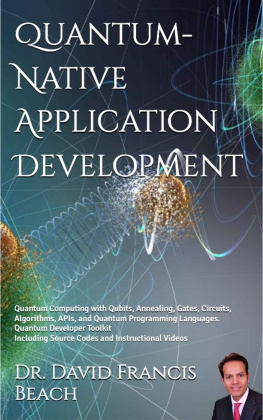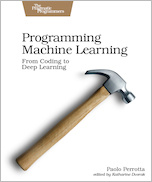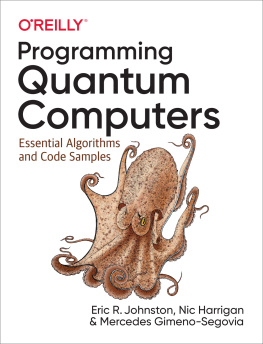Praise for The Pattern on the Stone
A delightful all-in-one introduction to computer science. Booklist
Most introductions to computers either take the reader on a mathematical journey through the workings of computer architecture and Boolean logic or introduce them to a particular program or product. Hillis, an innovative computer engineer, tries a different approach by explaining the basic concepts of the computer in everyday language. Everyone has sorted socks and played tic-tac-toe. Hillis uses these simple examples and similar everyday experiences to explain the ideas that make computers work. He takes the reader step-by-step from computer logic to programming to memory and compression. The final two chapters show how computers are truly close to being thinking machines. Highly recommended for anyone studying computer science or electrical engineering, this book is also a good read for anyone who wants a better understanding of how computers work. Library Journal
His conclusion is thoughtfully optimisticand appealing even to a skeptic. Wired
If youve ever tried to figure out how computers work, youve undoubtedly been told how simple they are. When Daniel Hillis tells you computers are simple, hes quite persuasive. Hillis and some friends once built a working computer out of tens of thousands of wooden Tinkertoys. Their device is now on display at the Computer Museum in Boston. The Pattern on the Stone illustrates basic computing concepts with line drawings of Tinkertoys in various positionsa surprisingly helpful approach. Hillis once drove a fire engine to work and he currently works for Disney, but theres nothing childish about his prose. The books gradual pace, low-tech design and gentle title are meant to bring hope to those who feel swamped by a tidal wave of computer-wrought change. And the approach succeeds, by showing the reader how humans, not magicians, discovered a few basic principles and built these amazing machines. The Industry Standard
An accessible, fascinating account of the fundamental processes that make computers tick. Hartford Courant


Grateful acknowledgment is made for permission from the following:
Illustration of the macaque visual cortex from Distributed Hierarchical Processing in Primate Cerebral Cortex, Cerebral Cortex 1: 147, courtesy of Oxford University Press.
Pablo Picassos Bernard Picasso with His Mother (1959); 1998 Estate of Pablo Picasso/Artist Rights Society (ARS), New York.
Photo of the Tinker Toy computer courtesy of The Computer Museum.
The Science Masters Series is a global publishing venture consisting of original science books written by leading scientists and published by a worldwide team of twenty-six publishers assembled by John Brockman. The series was conceived by Anthony Cheetham of Orion Publishers and John Brockman of Brockman, Inc., a New York literary agency, and developed in coordination with Basic Books.

The Science Masters name and marks are owned by and licensed to the publisher by Brockman Inc.

Copyright 1998 by W. D. Hillis.

Published by Basic Books,
A Member of the Perseus Books Group

All rights reserved. Printed in the United States of America. No part of this book may be used or reproduced in any manner whatsoever without written permission except in the case of brief quotations embodied in critical articles and reviews. For information address Basic Books, 250 West 57th Street, 15th Floor, New York, NY 10107.

First paperback edition 1999, Second paperback edition 2015
ISBN: 978-0-465-06687-2 (e-book)

Illustrations by Patricia Isaacs, Parrot Graphics

Library of Congress Cataloging-in-Publication Data
Hillis, W. Daniel.
The pattern on the stone : the simple ideas that make computers work / W. Daniel Hillis.1st ed.
p. cm.(Science masters)
Includes index.
1. Computers. I. Title. II. Series: Science masters series.
QA76.5.H4918 1998

10 9 8 7 6 5 4 3 2 1
CONTENTS


I have the opportunity to write an introduction to a second edition of this book because my publisher noticed an anomaly: a book on computers, written in the twentieth century, that continues to sell well into the twenty-first. It has now been translated into a dozen languages and it continues to be purchased (and presumably read) throughout the world. What accounts for the books longevity is that it is not about the technology or application of computers, which have changed completely since it was written, but rather it is about the fundamental principles of computers, which have not changed at all.
I must admit that I am a bit surprised, not that the principles from the beginning of the digital revolution are still relevant, but that so few have been added. Certainly the applications and technology of computers, and the art of programming them, have made extraordinary progress in the past decades. The impact on society has been astounding even to those who predicted it. Yet the ideas behind how computers work, the ideas described in this book, have remained the same. I have been given the opportunity to add new content to the book, but surprisingly to me, I see no new fundamental principles to add.
If anything, I am more tempted to subtract. It is not that anything turned out to be wrong, but some ideas just do not seem to require much explaining in the current millennium. For example, the discussions of parallel processing may seem obvious to a modern reader who uses the cloud of parallel computers every day. What is harder to understand is why so many twentieth-century experts believed that such parallel computers would never be practical. Also, the chapter on artificial intelligence may seem a bit defensive to the twenty-first century reader, who is probably more comfortable interacting with smart machines. Back in the twentieth century, many people were still queasy about the idea of intelligent computers. When the first chess grandmaster was beaten by a computer, many humans felt diminished. Yet less than two decades later, when a computer beat the human champions of a popular television quiz show, most viewers rooted for the machine. By then, computers were widely seen as more helpful than threatening.
Next page










